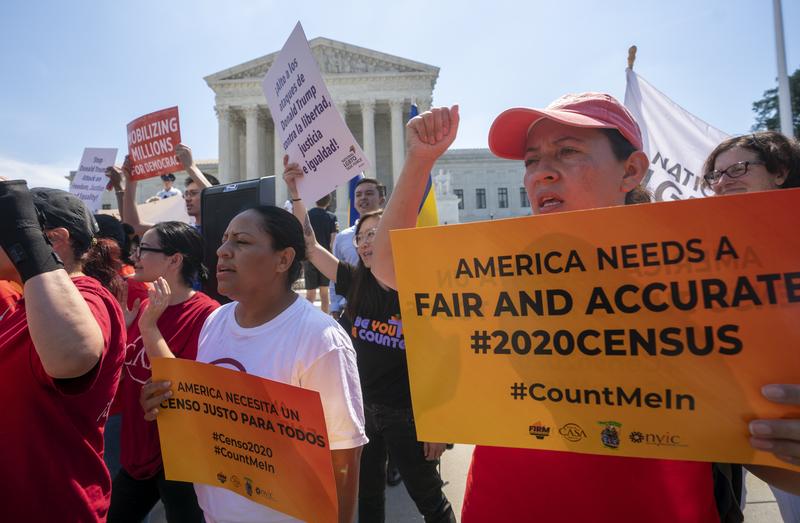Keeping White Power at the Polls

( AP Photo/J. Scott Applewhite )
KAI WRIGHT: Hey everybody, this is Kai. So, Super Tuesday has finally come, and now a lot more of us are voting. And we are certainly thinking about voting rights here on the show, past and present. Throughout this season, we’ve been looking back at the decades following the Civil War, finding unresolved questions and debates that haunt our politics today. And arguably, nothing haunts us more than the compromise Congress made when it wrote the rules that still govern voting in America. I can’t stop thinking about something Thaddeus Stevens said on the floor of Congress, way back in 1860s. He was one of the leading congressional abolitionists.
ERIC FONER: He gave this great speech in which he said, you know, “We have an opportunity here to create the perfect republic. And we've blown it.”
KAI: And maybe he was right. I’ll try to figure that out in an upcoming episode. But in the meantime, we’re gonna take a little break this week. So I wanna introduce you to one of my favorite podcasts, where I have learned a lot about voting and voter suppression that’s happening right now. The show is called What Next, and it’s hosted by Mary Harris. Mary is in my feed every single day, having these smart conversations that offer so much more than a digest of today’s headlines or a rehash of conventional wisdom. She’s constantly looking ahead, telling me what’s coming. I learn stuff, and I love that. So I wanna play you an episode of What Next that focuses on voting rights. In this episode, Mary’s talking to my friend and colleague Ari Berman, who is at Mother Jones magazine. Ari has spent years and years reporting on voter suppression, and he’s terrified about what he sees as the Republican Party’s plan to maintain white minority rule. Check it out, and go subscribe. And I’ll be back next week, with a new episode of The United States of Anxiety. For now, here’s Mary and Ari and What Next.
MARY HARRIS: Ari Berman's outlook on the world. You could call it a little cynical. To be fair, this is Ari's job. He's a reporter at Mother Jones.
ARI BERMAN: I cover attacks on democracy. I cover attacks on voting rights. And usually they don't say I'm going to suppress the vote X, Y and Z, two or four, 10 years ahead of time. The way voter suppression works is you try to surprise people. It's sort of a stealth tactic. So you don't know it's coming.
MARY: Ari came into the studio to tell me about the stealth tactic he thinks we're all going to be talking about next. One that could reshape whose votes count in this country for years.
DONALD TRUMP: Thank you very much, everyone.
MARY: Okay so I'm going to play this tape. This is July 11th.
ARI: Okay.
TRUMP: Are you a citizen of the United States of America? Oh, gee, I'm sorry. I just can't answer that question.
MARY: For Ari, the first sign of this new voter suppression tactic, that first surprised move -- he saw it back in July, when the president gave a press conference.
TRUMP: There used to be a time when you could proudly declare I am a citizen of the United States. Now they're trying to erase the very existence of a very important word in a very important thing: citizenship.
MARY: The Supreme Court had just ruled that the 2020 census could not ask about citizenship. It was one of those 5-4 rulings. Close, in other words. The president had spent a couple weeks insinuating he might somehow fight this decision. And then he gave the speech from the Rose Garden.
MARY: Do you want me to go forward a bit more?
ARI: Yeah, I want you to go forward a bit more because there’s one line that I want.
TRUMP: Today, I'm here to say we are not backing down on our effort to determine the citizenship status of the United States population.
MARY: At this press conference, Trump acknowledged the Supreme Court's ruling, but then he talked about this work around. He was issuing an executive order allowing citizenship data to be gathered by the government without altering the census.
TRUMP: This will greatly inform a wide array of public policy decisions. This information is also relevant to administering our elections. Some states may want to draw state and local legislative districts based upon the voter eligible population.
MARY: And this part. This is where Ari wanted to stop the tape.
MARY: Why did that moment stand out to you?
ARI: It's one line that could easily be buried as very wonky and technical. But to me, this was the smoking gun moment from Trump's press conference, because he's making clear that he wants this citizenship data for redistricting purposes. He wants to take the data so that districts are drawn to not just include non-citizens, but he says the voter eligible population. That means children as well would not be counted. And for decades, the way districts are drawn is everyone counts. Trump is saying, I want to do something totally different. I want to exclude everyone who is not eligible to vote from counting. When everyone saw the headline “Trump Dropping Citizenship Question,” that was the headline that came out of the press conference -- I saw a completely different story.
MARY: Today on the show, we're going to tell the story that Ari sees coming. A story about a radical reshuffling of which people count in the United States. I'm Mary Harris. You're listening to What Next. Stick with us.
[Pause]
MARY: As Ari was watching this press conference that President Trump gave in July, he knew right away that if states took the president up on his offer, asked for this citizenship data, it could harm one party more than another. Because Democratic districts -- they tend to be younger, more diverse.
ARI: That's right. So in July, Trump says, I want to do this executive order so that the federal government will collect the citizenship data, even though it's not going to be on the 2020 census. And I want to do it for redistricting purposes, so districts can be drawn to exclude non-citizens and potentially children so that that will then make those districts whiter and more Republican, because generally speaking, Democrats represent more diverse districts that have more children and more non-citizens. Republicans tend to represent whiter districts with more citizens and more older people.
MARY: And sure enough, right after Trump unveiled his new executive order, Republican redistricting experts began talking to state legislators about how they could benefit from the new rules.
SPEAKER: Let's begin with this, ladies and gentlemen: you are going to be sued. Let's start with that.
MARY: Slate got this audio from a meeting of some of these experts back in August, just after Trump's speech. They're talking about techniques for drawing district maps, Republican maps, with state legislators. They tell these politicians, if you do your job well, you're gonna get sued. Someone's going to say what you did wasn't fair. One expert even encourages people in the room to throw away the notes they're taking so they won't be caught plotting.
SPEAKER: Your notes from this conference in this workshop will probably be part of a discovery demand. So my advice to you is, if you don't want it turned over in discovery, you probably ought to get rid of it before you go home.
ARI: And I mean, if -- it's sort of telling because if Republicans were following normal redistricting principles, they wouldn't be sued. But clearly, there is some sort of deviation from what is considered acceptable standards. Otherwise they wouldn't be worried about facing all of these lawsuits.
MARY: Ari focused in on this one panelist in particular, a guy named Hans von Spakovsky.
ARI: Hans von Spakovsky -- who is an expert at the Heritage Foundation, an official in the Bush administration, a former member of Donald Trump's election integrity commission, with a very long record of advocating policies that would make it harder for some people to vote -- says outright to these state legislators: you should consider drawing districts to exclude non-citizens. And the reason you should do so is the higher the number of noncitizens in a district, the more likely it is to be a Democratic district. So he's basically saying that if you change how districts are drawn, it will help the Republican Party.
MARY: Hm. He says -- he actually says liberals do not want you doing this. The higher the number of noncitizens in a district, the greater the chances they're gonna vote for a liberal. But it -- it can't be that their outward justification is about preserving white political power. But it sounds pretty close.
ARI: If this is challenged in court, they will probably have a different rationale for why they want to do it. But certainly the stated rationale by Hans von Spakovsky and others is that he believes drawing districts in such a way to exclude non-citizens and potentially to exclude children from counting will help Republicans at the expense of Democrats. I mean, they could say we want to do this for political reasons, but if you look at who's going to be harmed, it's overwhelmingly going to be communities of color. If districts are drawn in such a way to not count noncitizens and to not count children, there was a study done by the Leadership Conference on Civil Rights. They found that 55 percent of Latinos, 45 percent of Asian-Americans and a third of African-Americans would not be counted towards political representation. That's a staggering number of people to not be counted. More than half of Latinos in the United States are suddenly not going to be counted? So this is why I think this is such a big deal, because you're not talking about excluding a few people or 10 people from political representation. You're talking about excluding millions and millions of people and entire communities from being counted altogether.
MARY: Well, we should say, though, 21 percent of white people would also be excluded. But of course, they're the lowest percentage in there.
ARI: There's always going to be collateral damage, right? I mean, even when it comes to voter suppression laws, there's always going to be white Republicans that are disenfranchised, too. There is going to be more of the other people that get hit by this. And so I think Republicans are thinking, yeah, this might hurt white people in certain areas. But by and large, the districts that we want to change are districts that are going to be very diverse, heavily urban districts that are more than likely to be represented by Democrats. And we might lose a Republican seat here. You might lose a Republican seat here. But Democrats are going to lose far more seats than Republicans are.
MARY: Can we just hone in on exactly how this would work? Because my understanding, looking at your reporting is that when you stop counting all the people, it means that there are less representatives overall because there are less people that you're counting to represent. And so because there are fewer representatives, those representatives are going to be dealing with the concerns of more people. And then there will be these people who are sort of there but not counted and and their concerns will probably be drowned out. And I des -- am I understanding it right?
ARI: That's exactly right. So the Supreme Court has said that districts need to be roughly equal in population. But if you're not counting everyone, if you're only counting eligible voters, that means that districts that have fewer eligible voters have to take in more population. So they have the same number of eligible voters as a surrounding district. So, for example, I told this story from a district in Houston, Texas that has 850,000 people. A state Senate district. That's already a pretty big district. I mean, 850,000 people for a state senator, that's more than most members of Congress represent. Half of her constituents can't vote because they're either under 18 or they're non-citizens. It's a very heavily Latino district in Houston and the surrounding areas. So what would happen to her is because she doesn't have enough eligible voters, her district would increase to over a million people. And depending on how you drew the district, her district could either be combined with another Democratic district to eliminate a Democratic district altogether, or you could put a ton of Republican voters who are eligible voters from a surrounding district into her district so that it's no longer a Latino majority and she potentially no longer has her seat. So...
MARY: Because those are the kind of people who potentially wouldn't vote for her.
ARI: Exactly. If you're taking like, white conservative Republicans from suburban Houston or even exurban Houston or even rural Texas, some of these state senate districts are pretty big geographically. Are they going to want to vote for a Latina Democrat? Not necessarily.
MARY: So in the end, there's an issue of not just voters and nonvoters having their issues not really represented because their representatives are overwhelmed and there are fewer of them, there's also the issue of less representation by minorities in the actual statehouses because essentially the districts will be drawn to favor the white population.
ARI: Exactly. There would be fewer minority legislators altogether. One study found that if Texas was to adopt a plan to exclude non-citizens and children from counting towards representation, Latino legislators would have their lowest level of representation since the 1980s. So they would literally go four decades backwards.
MARY: Ari says the United States has been having this argument about who to count since the country was founded. But the current debate -- it really took shape after the Civil War with the ratification of the 14th Amendment. Back then, the people arguing to count only voters -- they were making a kind of civil rights argument. They worried Southern states would get more political power if black residents were counted and then weren't able to vote. But others said it would be dangerous to exclude nonvoters. What about women, children, people who might not be able to participate in the election but still needed representation? So, Fourteenth Amendment passes and for congressional districts, just about everyone counts.
ARI: And so that seems to at least settle the debate over congressional representation. But then states get around that by doing something else, which is drawing districts that are wildly unequal in population. In virtually every state you had rural legislators with far more representation than urban ones. For example, California had a law that said no county could have more than one senator. So what happened was L.A. County, with six million people, had one senator and then three counties with 14,000 people east of the Sierra Madres in California, had one senator. So six million people have the same level of representation as 14,000 people. 10 percent of the public could elect a majority of the state senate because of the way districts are drawn. So there's examples I give about gerrymandering today. The most extreme example is that in Wisconsin in the last election, Republican candidates for the state assembly got 46 percent of the votes, but 64 percent of the seats in the state legislature.
MARY: That sounds like chump change compared to California back in the day.
ARI: Exactly. I mean, that's really bad. I mean, getting 46 percent of the vote and 64 percent of the seats just seems inherently unfair. But it's a lot more fair than getting 10 percent of the votes and a majority of seats, which is what happened before the one person, one vote cases.
MARY: These one person, one vote cases -- they were ruled on by the Supreme Court in the 60s. They established that every person's vote, no matter where they lived, would be given the same weight.
ARI: The composition of the Supreme Court changed in the 1960s, and the problem of population inequality got so bad, the Supreme Court could no longer look away. And they came up with this idea of one person, one vote as a catch phrase to say that districts have to be roughly equal in population. And Earl Warren, the chief justice at the time, had a famous phrase where he said legislators represent people, not acres or trees.
MARY: And the 14th Amendment means that in Congress, districts are drawn based on total population. But the courts actually never definitively ruled on whether state legislative maps have to count everyone. And this gap -- it's what conservative activists are hoping to exploit.
MARY: So how did the idea of one person, one vote come up for debate again in the last decade?
ARI: It came up again, largely because of a person named Edward Blum. He is a conservative activist from Texas who founded a group called the Project on Fair Representation to try to challenge what he viewed as unfair racial preferences in public policy. So he is best known for bringing cases challenging the Voting Rights Act and challenging affirmative action.
MARY: Yeah, when I looked him up, I found this ACLU article that called him “The Man Who Wants to Kill Affirmative Action.”
ARI: And he's the man that literally did kill the Voting Rights Act because he brought the case, Shelby County vs. Holder, that led to the Supreme Court gutting the Voting Rights Act in 2013. He himself is not a lawyer. So what he does is he finds plaintiffs and then he pairs them with some of the best lawyers in the conservative movement and he pays the legal fees. So essentially, he's doing the reverse of what the NAACP Legal Defense Fund and other civil rights groups do. Remember, that's how Brown vs. Board of Education and these other cases were brought. Civil rights groups found plaintiffs to challenge discriminatory laws and then they organized these cases.
MARY: So he's like a one person version of that.
ARI: He's a one person version of that with some very powerful and very deep pocketed supporters.
MARY: When you spoke to Edward Blum, how did he explain his rationale here?
ARI:He started thinking about changing the definition of one person, one vote back in the 1990s when he was living in Houston, Texas. And Houston in 1997 drew four new districts that were supposed to boost minority representation, two districts that were designed to be held by African-Americans, two districts that were designed to be held by Latinos. And Ed Blum viewed this as essentially an example of affirmative action in the electoral sphere, because you're basically saying we're going to draw these districts for minorities.
MARY: Did he feel silenced?
ARI: He felt silenced. But when he dug beneath the surface, he noticed a different issue, which is that the districts that were going to be represented by minorities had far fewer eligible voters than districts that were represented by whites. And he thought that meant that the voters in those districts had far more power because there were many fewer of them compared to the surrounding white districts. And he thought this violated one person, one vote. So he didn't think he was trying to overturn one person, one vote. He thought he was trying to preserve the original meaning of that phrase.
MARY: Hm. So we talked about how President Trump has sort of opened this window to this idea that we're only counting eligible voters. How is Edward Blum involved in the current push? I mean, he's not part of the White House. So how is he getting involved?
ARI: Well, Edward Blum laid the groundwork for what the Trump administration did because in 2014, he brought a case against the state of Texas where he told the state of Texas, you have to draw your state senate districts to not count non-citizens for purposes of redistricting. This went all the way to the Supreme Court. And in 2016, the Supreme Court said you can't force Texas or any other state to draw districts excluding noncitizens or other populations if they don't want to.
MARY: If they don't want to.
ARI:If they don't want to.
MARY: So if they want to…
ARI: They left that question open.
MARY: But the reason states didn't immediately start prepping redistricting plans after this ruling is that they didn't have all the information they needed. Citizenship data -- for a long time, it’s been pretty hard to come by.
ARI: That's where Trump's executive order comes in. Now, theoretically, states are going to get the citizenship data that could be used to exclude non-citizens and potentially children from counting towards representation. And Ed Blum can go to all of those states and say, now you have the data. And by the way, if you decide to do it, I'll have your back in court.
MARY: He told you he was having phone calls with people from all over the country, right?
ARI: He said that his phone was essentially ringing off the hook from Republican officials or political consultants who are interested in this idea. And he told me people in five different states had contacted him.
KAI: If you learned something in that discussion, go subscribe to What Next. And I will see you back here next week with a new episode of The United States of Anxiety.





